Content from the Brookings Doha Center is now archived. In September 2021, after 14 years of impactful partnership, Brookings and the Brookings Doha Center announced that they were ending their affiliation. The Brookings Doha Center is now the Middle East Council on Global Affairs, a separate public policy institution based in Qatar.
Tensions between the United States and Iran are escalating rapidly, particularly since U.S. warships were dispatched in response to reported threats against U.S. forces in Iraq from Iran and its proxies. The U.S. has withdrawn all non-emergency embassy staff from Iraq and, on Monday, a mortar attack by Iran’s proxies in Baghdad, striking in the vicinity of the U.S. embassy, raised the prospects of a conflict on Iraqi soil even further.
A momentum toward conflict could intensify if U.S. personnel are attacked or if the U.S. were to preemptively strike Shiite militias in Iraq or elsewhere in the region. Iraq could end up falling victim to a potential conflict. The war-fatigued country is an important arena for pushing back against Iranian influence. Some of the region’s most powerful Iranian proxy groups are Iraqi groups that honed their battlefield superiority against U.S. forces after the 2003 invasion of Iraq, and during sectarian conflicts between Iraq’s Arab Sunnis and Shiites.
Conflict—were it to break out—between the U.S. and Iran on Iraqi soil would disrupt a delicate political equilibrium that has emerged since last year’s elections and the territorial defeat of ISIS. America’s timing could not be worse. The power-sharing consensus is still fragile and vulnerable, to the extent that a major disruption could lead to a political implosion in Baghdad.
Such an implosion would almost certainly trigger deadly clashes in a political environment that is still defined by zero-sum, battle-for-survival politics, arguably even a civil war. The tone is already being set: Powerful cleric Muqtada al-Sadr, who commands a militia that has fought deadly battles with Iran’s proxies, has already delivered a stark warning that any attempt to draw Iraq into a U.S.-Iran conflict would be akin to declaring war on all Iraqis.
The U.S. must grasp the magnitude of the crisis Iraq could face if a clash with Iran draws in Iran’s proxies. That could result in a series of unintended consequences and second-order effects that might lead to substantial domestic bloodshed, the resurgence of ISIS, and a revival of sectarian conflict. Such violent instability will enable precisely the kind of environment in which Iran’s proxies thrive.
The U.S. must grasp the magnitude of the crisis Iraq could face if a clash with Iran draws in Iran’s proxies.
A PRIMER ON IRAQ’S SHIITE MILITIAS
Iraq’s Shiite militia groups—like Ketaib Hezbollah, Harakat al-Nujaba, and Asaib ahl al-Haq—have established themselves as powerful transnational actors whose ambitions and fighting capabilities extends far beyond the territorial borders of Iraq. Some have been critical to the Assad regime’s victories in Syria, for instance.
Any possible U.S. confrontation with Iran would need to incorporate a strategy that secures a favorable Iraqi political landscape in the aftermath, one that enhances U.S. leverage in Iraq and ensures Iran’s influence is not reinforced in the future.
Importantly, Iran’s proxies in Iraq are more than militia groups and more than simply Iranian proxies. They are resource-rich actors who are heavily entrenched in the Iraqi political system. They contest elections and hold seats in parliament. Their fighters are constitutionally mandated as members of the Iraqi armed forces, providing them with salaries from the Iraqi national budget.
Most importantly, Iran-aligned groups have considerable arms and finances that also allow them to operate independently of the state and confront Iraq’s conventional armed forces where necessary. In other words, the Iraqi government is too weak to rein in militias that have the capacity and willingness to turn Iraq into a launching pad for attacks on the U.S.
THE US LEGACY IN IRAQ
These are not new lessons. Since 2011 the U.S. has been its own worst enemy. It has been a bystander to expanded Iranian influence in Iraq since the withdrawal of its troops in 2011, when the Obama administration left a political and security void that was immediately filled by Iran. Following the withdrawal, militia groups re-mobilized, band-wagoning with parties such as the then-ruling Islamic Dawa Party, which equipped them with state resources, status, and greater legitimacy.
Under America’s watch, then-Prime Minister Nouri al-Maliki (backed by Washington) marginalized and suppressed leading Arab Sunni figures, many of whom were vehemently against Iranian meddling in Iraq. The Iraqi army was also mismanaged and corrupted, resulting in its fall when ISIS seized Mosul in 2014.
The rise of ISIS in 2014 was arguably the most seminal moment in the history of Iraq’s Shiite militias, who filled the security vacuum left by the collapse of the army. U.S. intervention in Iraq to defeat a brutal terrorist organization was imperative, and Washington and Tehran found a common enemy. But U.S. resources and weapons ended up in the hands of Iran-aligned groups and, despite its substantial contribution to the defeat of ISIS, the U.S. failed to devise policies to contain those groups’ prominence over the past five years.
The U.S. and Iran found themselves on the same side yet again in September 2017, this time against longstanding U.S. allies the Kurds. Both opposed the Kurdish independence referendum, but it was Iran that capitalized on the resulting domestic and regional fractures, exploiting tensions between the Kurdish capital of Erbil and Baghdad to ultimately shape a post-referendum environment conducive to its expanded influence. The United States, in contrast, didn’t even try to forge a settlement between Erbil and Baghdad and became a mere observer of the politics that followed. It even recklessly declared it would not come to the Kurds’ aid if any hostile actors moved on the Peshmerga (effectively a green light for Iran’s proxies).
Indeed, one month later, Iran orchestrated a military offensive into Kirkuk, an operation that involved the use of U.S. Abrams tanks against the Peshmerga. Kurdistan was once a critical front line for containing Iran, but the Kurdish leadership is now focused on establishing constructive relations with Iran, a powerful neighbor that the Kurds learned they could ill-afford to aggravate.
WHAT THE US SHOULD DO
These events show that containing Iran requires an appreciation for the episodic moments that can collectively or individually shift the balance of power in Tehran’s favor. Learning from these mistakes is critical to shaping a landscape that provides Washington with a competitive edge over Iran. The U.S. must play the long game.
A political strategy can re-mobilize America’s allies and help right the wrongs of the past. This will be an admittedly difficult strategy, especially during its formative stages, since Washington’s friends are too bruised, bloodied, and fatigued—and too distrustful of America’s intentions. That trust must be restored, since those friends could still be a critical U.S. vanguard but would also be the first casualties in a potential conflict.
A more belligerent U.S. policy is already forcing Iran and its proxies to look over their shoulder and has even forced a more moderate tone from these actors in recent days. Washington’s goal should be twofold: creating a favorable political environment that suppresses the malign actions of Iran’s proxies, and empowering and providing a safety net for U.S.-aligned groups.
The U.S. should firstly reinforce and strengthen Prime Minister Adel Mahdi and prevent his rivals from attempting to force his downfall. That requires reining in former prime-minister Haidar al-Abadi and mobilizing a political coalition with the support of the British and Europeans to prevent him and his allies from continuing to undermine Mahdi.
Abadi was a favorite in Washington and London, which backed him vehemently at great expense to stability and traditionally Western-aligned Iraqi factions. Although some in Washington and elsewhere may still be supporting his return to the helm, that would be catastrophic for Iraq and the U.S. Abadi came in a disastrous third place in the 2018 elections, leaving a toxic legacy because of his poor governance and the immense public mistrust in the government that followed.
Prime Minister Mahdi is satisfying the legitimate interests of once-alienated communities. A proactive and politically interventionist U.S. role—backed by the threat of U.S. military intervention—can help forge a pathway toward a political climate in Baghdad that is conducive to a healthy balance of power domestically; one that allows the Iraqi government to balance its relations with the U.S. and Iran and that also enables viable and functioning institutions.
The U.S. must also develop a sustainable policy for those situations where its allies are militarily weaker or disadvantaged in the face of far superior opponents, but where it is unwilling or unable to provide those actors with heavy weaponry to defend themselves. In situations like those that unfolded in Kirkuk in 2017, the U.S. must draw and enforce red lines to ensure that the balance of power does not shift in Iran’s favor. Iran’s proxies are also banking on the U.S. disengaging at some point. Will the U.S. stay or go? Building on the current troop levels or making it clear to friends and enemies alike that the U.S. is here to stay for some time will go a long way toward reassuring America’s allies and maintaining a check on Iran’s attempts to solidify its influence in Iraq.
The U.S. could opt to play the role of disruptor, giving Iran-aligned groups a bloody nose and engulfing Iraq in tumult and armed conflict in the process. But toward what end? The net result is the suppression of the groups that have longed for the containment of Iran or, alternatively, a healthy of balance of power in a country that has increasingly shifted into Iran’s orbit. These are the political elites, social movements, and civil society actors that seek and have invested in establishing the sort of environment that suppresses the space for militia groups.
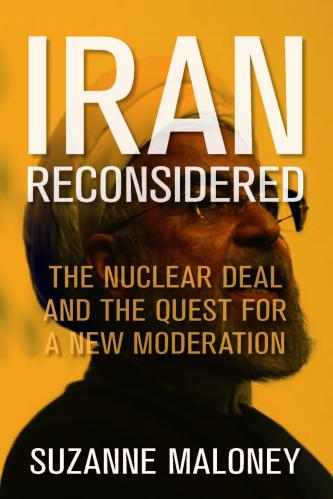
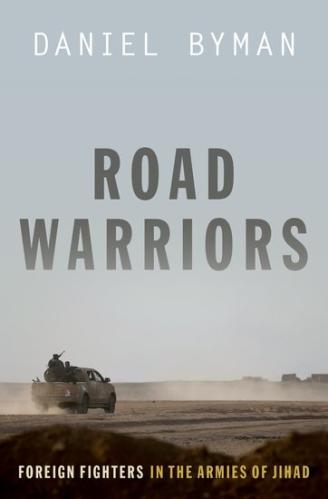
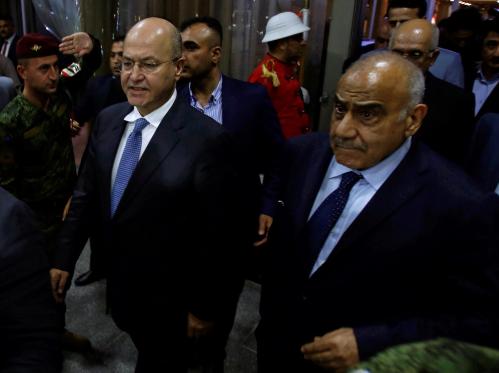
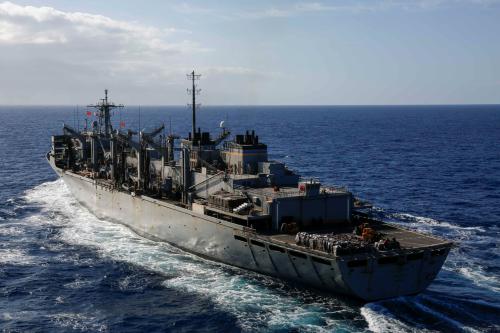


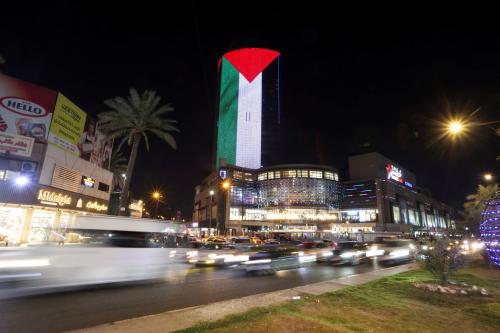
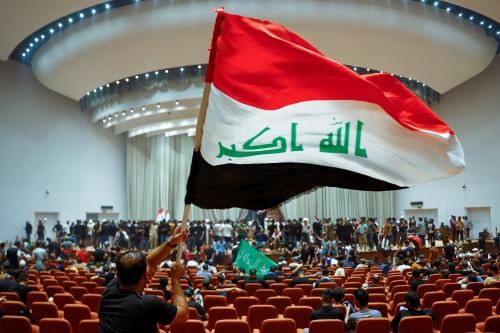
Commentary
How US-Iran tensions could disrupt Iraq’s fragile peace
May 23, 2019